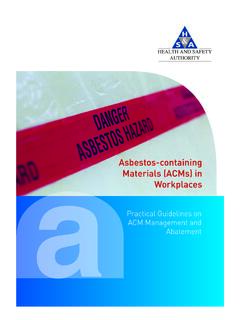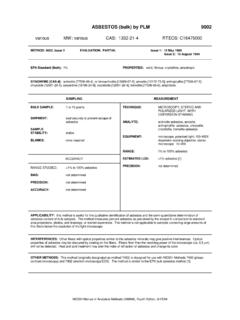Transcription of Measurement of Fibers - Centers for Disease Control and ...
1 DEPARTMENT OF HEALTH AND HUMAN SERVICES Centers for Disease Control and Prevention National Institute for Occupational Safety and Health NIOSH Manual of Analytical Methods (NMAM), 5th Edition Measurement of Fibers by Paul A. Baron, , NIOSH Adapted from Baron [2001] The NMAM team gratefully acknowledges Chen Wang, Joe Fernback and Alan Dozier for insightful review of this chapter. 1 Introduction FI-2 2 Fiber dimensions FI-5 3 Phase contrasting light microscope counting (PCM) FI-6 4 Polarizing light microscopy (PLM) of bulk materials FI-14 5 Electron microscopy FI-17 6 Scanning electron microscopy (SEM) FI-18 7 Transmission electron microscopy (TEM) FI-18 8 Optical detection (light scattering) FI-20 9 Fiber classification FI-21 10 Conclusions FI-22 11 References FI-23 NIOSH Manual of Analytical Methods 5th Edition Chapter FI April 2016 Page FI-2 of FI-31 Measurement of Fibers 1 Introduction Fiber-related Disease has provided much of the impetus for fiber research in recent years.
2 asbestos has been the fiber type most commonly associated with Disease . The name asbestos is a commercial term applied to the fibrous forms of several minerals that have been used for similar purposes and includes chrysotile, amosite, crocidolite, and the fibrous forms of tremolite, anthophyllite, and actinolite. The three primary diseases associated with asbestos exposure are asbestosis, the result of inflammation and collagen formation in lung tissue; lung cancer; and mesothelioma, an otherwise rare form of cancer associated with the lining surrounding the lungs. A current theory describing the toxicity of Fibers indicates that fiber dose, fiber dimension, and fiber durability in lung fluid are the three primary factors determining fiber toxicity [Lippmann 1990].
3 The dose, or number of Fibers deposited in the lungs, is clearly an important factor in determining the likelihood of Disease . Both fiber diameter and length are important in the deposition of Fibers in the lungs and how long they are likely to remain in the lungs. Figure 1 indicates some of the factors that determine fiber deposition and removal in the lungs. Fiber length is thought to be important because the macrophages that normally remove particles from the lungs cannot engulf Fibers having lengths greater than the macrophage diameter. Thus, longer Fibers are more likely to remain in the lungs for an extended period of time. The macrophages die in the process of trying to engulf the Fibers and release inflammatory cytokines and other chemicals into the lungs [Blake et al.]
4 1997]. This and other cellular interactions with the Fibers appear to trigger the collagen buildup in the lungs known as fibrosis or asbestosis and, over a longer period, produce cancer as well. Fiber diameter is also important because fiber aerodynamic behavior indicates that only small diameter Fibers are likely to reach into and deposit in the airways of the lungs. The smaller the fiber diameter, the greater its likelihood of reaching the gas exchange regions. Finally, Fibers that dissolve in lung fluid in a matter of weeks or months, such as certain glass Fibers , appear to be somewhat less toxic than more insoluble Fibers . The surface properties of Fibers are also thought to have an effect on toxicity.
5 asbestos is one of the most widely studied toxic materials and there have been many symposia dedicated to and reviews of its behavior in humans and animals [Selikoff and Lee 1978; Rajhans and Sullivan 1981; WHO 1986; ATSDR 1990; Dement 1990]. NIOSH Manual of Analytical Methods 5th Edition Chapter FI April 2016 Page FI-3 of FI-31 Measurement of Fibers Figure 1. Schematic of mechanisms that affect fiber deposition and retention in the lungs. The deposition depends on all the indicated parameters in a complex fashion. However, larger diameter particles are affected more by gravitational settling, impaction, and interception, resulting in greater deposition further up in the respiratory tract.
6 The saddle points, or carinae, in the branching respiratory tree are often a focal point for deposition of larger diameter Fibers . Smaller diameter particles are affected more by diffusion and can collect in the smaller airways and gas exchange region (alveoli). Particle removal from the lungs is primarily effected by the cilia coating the non-gas exchange regions of the lungs; the cilia push mucus produced in the lungs and any particles trapped in the mucus out of the lung and into the gastrointestinal tract in a matter of hours or days. Some Fibers are sufficiently soluble in lung fluid that they can disappear in a matter of months. Finally, white blood cells or macrophages roam the gas exchange regions and ingest particles deposited there for removal through the lymph system.
7 Human macrophages are approximately 17 m in diameter and can only ingest particles smaller than they are. Therefore, thin Fibers are likely to deposit in the gas exchange region and, of these, the long insoluble Fibers can remain in the lungs indefinitely. NIOSH Manual of Analytical Methods 5th Edition Chapter FI April 2016 Page FI-4 of FI-31 Measurement of Fibers Several techniques were used for asbestos Measurement up until the late 1960s [Rajhans and Sullivan 1981]. Earlier than this, it was not widely recognized that the fibrous nature of asbestos was intimately related to its toxicity, so many techniques involved collection of airborne particles and counting all large particles at low magnification by optical microscopy.
8 Thermal precipitators, impactors (konimeters), impingers, and electrostatic precipitators were all used to sample asbestos . Perhaps the primary technique in the United States (US) and the United Kingdom (UK) during this early period was the liquid impinger, in which particles of dust larger than about 1- m aerodynamic diameter were sampled at L/min and impacted into a liquid reservoir [Rajhans and Sullivan 1981]. After sampling, an aliquot of the liquid was placed on a slide in a special cell, particles larger than 5- m size were counted, and the results were reported in millions of particles per cubic foot. Dissatisfaction with this approach stemmed from lack of correlation between measured particle concentration and Disease in the workplace.
9 Various indices of exposure have been developed that attempt to relate a portion of the fiber size distribution to the toxic effects. The appropriate indices for each of the asbestos related diseases as a function of fiber length and diameter (Figure 2) were suggested by Lippmann [Lippmann 1988]. Figure 2. Comparison of proposed size ranges of asbestos Fibers causing specific diseases compared with the fiber sizes detected using TEM and PCM techniques. Lung cancer and mesothelioma are more likely to occur at current occupational and environmental levels than asbestosis. PCM can cover only a portion of the total fiber distribution; PCM is used as an indicator of total exposure. TEM can cover the entire size range, but most methods emphasize one size range over another through selection of magnification and counting rules.
10 NIOSH Manual of Analytical Methods 5th Edition Chapter FI April 2016 Page FI-5 of FI-31 Measurement of Fibers 2 Fiber dimensions Fibers are particles that have one dimension significantly larger than the other two. Fibers are often characterized or selected according to their aspect ratio, , the ratio of the large dimension to one of the small dimensions. If no other criteria are used, then materials that might not normally be considered fibrous may contain a fraction of particles that meet the criteria for Fibers . The distribution of fiber dimensions in a sample can usually be characterized by assuming a cylindrical geometry ( , the two small dimensions are identical) and measuring the length and diameter of individual Fibers .












